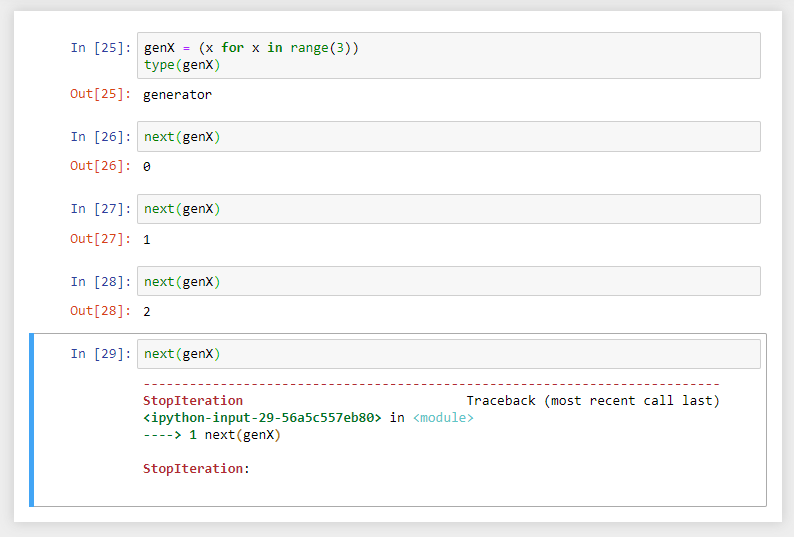Getting started with Python Part II

- IF Elif Else
- For For-Else
- While While-Else
- Nested Statements
- Controlling a Loop
- Exceptions Handling
- Functions
- Namespaces
- Importing Modules
- Working with Files
- Regular Expressions
- Object Oriented Programming
- Comprehensions
- Lambda Functions
- Maps
- Filter
- Iterator
- Generator
- Itertools
IF Elif Else
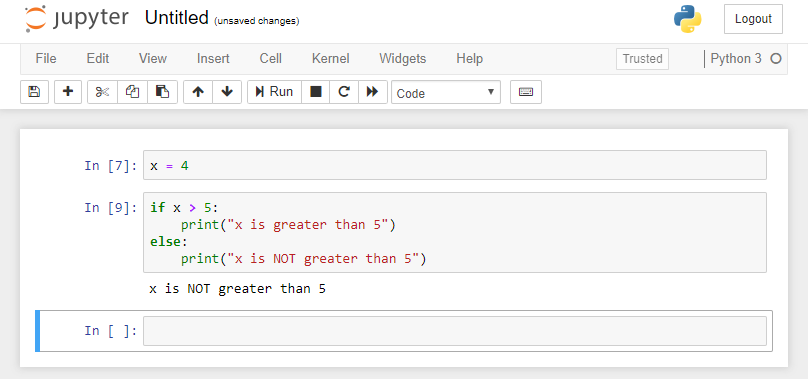
For For-Else
Looping through Arrays
Looping through Strings
Working with Ranges
We can use the len() function to assign an index to an array, loop through the elements and print out their by their assigned index:
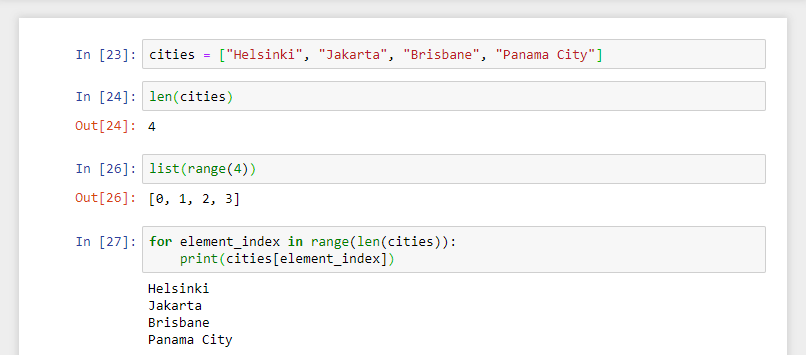
A similar result can be achieved with the enumerate() function, that will give us both the index, as well as the value of the array element:
We can also add an Else statement to the For Loop that is triggered when the loop reaches the end of the list:

While While-Else
Nested Statements
If
The first If Statement checks if the string has the letter a in it. If true, the second if statement is triggered and checks if the length of the string is greater than 6. Only if both statements are true, we will get a printout of the string itself and it's length:
This code can be shortened by using the And Operator instead of the inner if statement:
For
While
In the following nested While Loop we have x being incremented with each loop until x reaches the value of 10. Each time the first while loop runs, the inner while loop is triggered to run until the value of z reaches 10. This is repeated ten times until x = 10:
Controlling a Loop
Break
The loop runs until the if statement becomes True and the break command is executed.
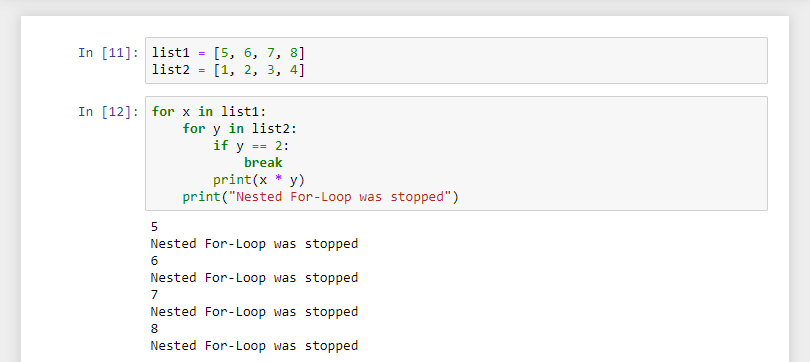
In the second example we have a for loop that tries to multiply every element of list1 with every element in list2. But the Break command stops the execution when the last element of list2 is reached:
5 x 1 = 5
5 x 2 => break
6 x 1 = 6
6 x 2 => break
7 x 1 = 7
7 x 2 => break
8 x 1 = 8
8 x 2 => break
Continue
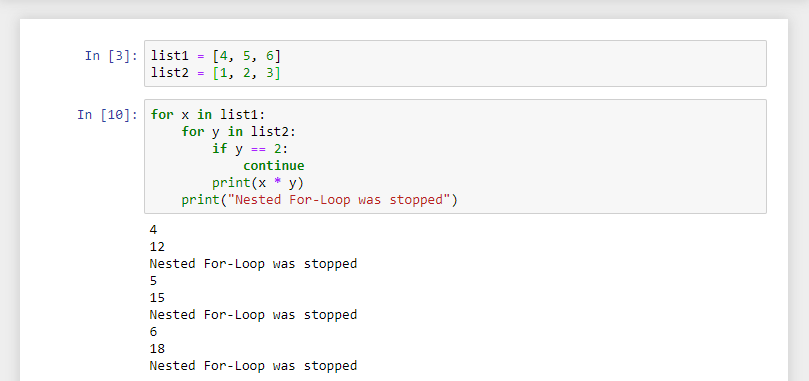
The Continue command is triggered when the second element of list2 is reached in the multiplication. But, unlike the Break command, it does not stop the execution of the following multiplication:
4 x 1 = 4
4 x 2 => break
4 x 3 = 12
5 x 1 = 5
5 x 2 => break
5 x 3 = 15
6 x 1 = 6
6 x 2 => break
6 x 3 = 18
Pass
The pass statement is just a placeholder that does nothing on execution - for debugging reasons or during the early concept phase of development.
Exceptions Handling
The function is trying to divide all members of the range by Zero, which would cause ein Exception Error in our code. But because we wrapped our function in a try/except block, the error triggers the code below the except command instead of just crashing the program. If the first function is successful, the exception code is not triggered.
To catch all possible errors, just don't specify the error you are looking for - above we only caught ZeroDivisionErrors. But it is recommended to rather add all possible errors to the block instead, to be able to differentiate between the possible root causes of the error (Catching all errors just gives you a generic error message):
For debugging purposes you can also add an Else Clause at the bottom to get a feedback when a function was executed successfully:
The code behind a Finally Clause - unlike with Else - is execute wether the function inside the Try Block was successfully executed or not.

Functions
Functions are code blocks that are reuseable and follows this general syntax:

A function can be given an argument:
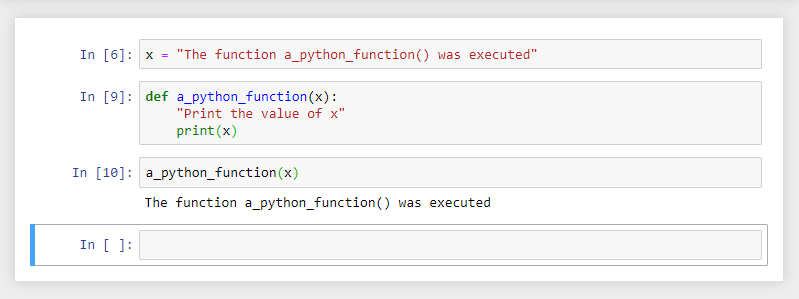
When creating a variable inside a function, this needs to be returned, to be able to further process it:
Arguments
In the example above, the position of the argument is mapped to according to the parameter definition - so the first argument is assigned to x and the second one becomes the value of y. This is called a Positional Argument.
The function can also be used with Keyword Arguments, where the arguments are assigned explicitly:
Positional and Keyword arguments can be mixed - but the Keywords always have to follow the Positionals:
You can also define a value by a Parameter default:

This parameter is used as the default value - note that you can overwrite it by adding a different value as an argument when calling the function:
When working with an unknown amount of arguments, you can add an empty tuple as a parameter to your function definition:
For Keyword Arguments the expression **kwargs is used:
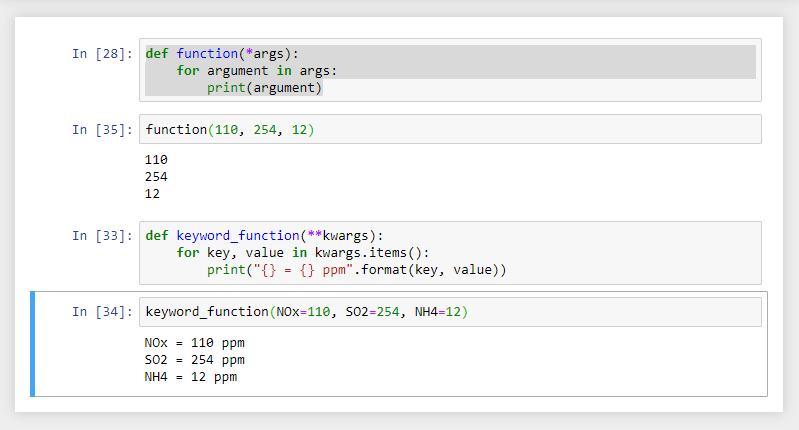
Namespaces
Namespaces allow you to define multiple version of the same function or class, separated by different namespaces they are in. Python comes with 3 types of namespaces:
- The built-in namespace for built-in functions like
len(),max(), etc. - The global namespace contains all functions you define or import into your program.
- The local namespace is used inside the context of a particular function.
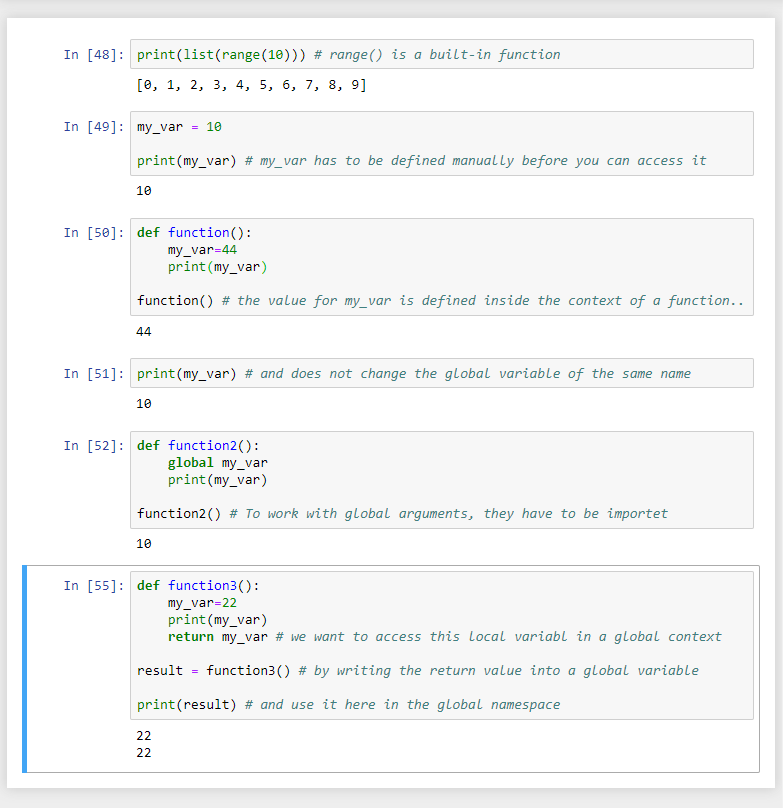
Importing Modules
Python comes with a variety of modules that group sets of built-in functions. There are also plenty 3rd party modules / libraries available that can be downloaded and installed. They are brought into your program using the import statement:
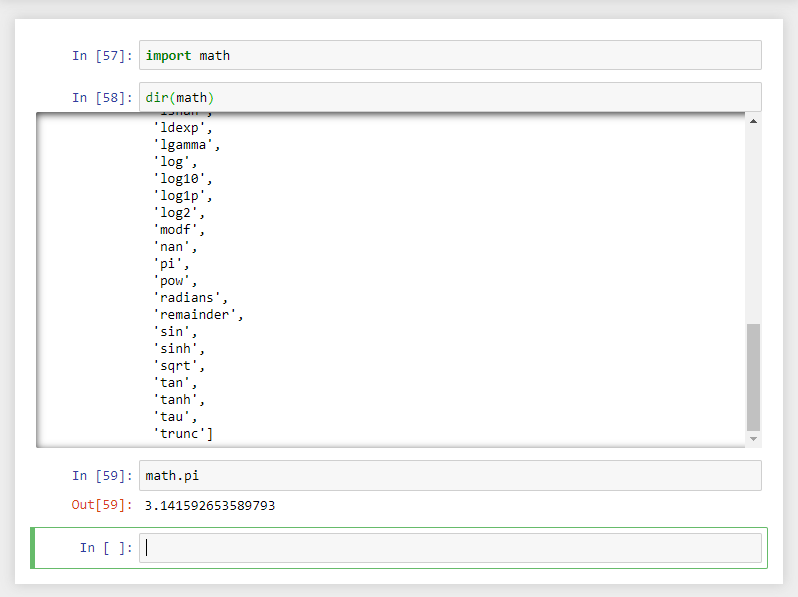
Custom Module
You can create a custom module by defining them in Python file, e.g. my_module.py :
my_var = 224
def my_function():
print('The function was called')
And importing it with the import statement into the global namespace of your program:
import my_module
print(my_module.my_var)
my_module.my_function()
To keep your code light, you can also just import a single element from a module:
from my_module import my_function
my_function()
Thirdparty Modules
Thirdparty modules can be installed with the pip package manager. For example if we want to install the open source software library for high performance numerical computation Tensorflow, but we want to use the newest alpha version of it:
python -m pip install --upgrade pip
pip install tensorflow==2.0.0-alpha0

Note: if you get the following error - you have Python 32bit installed. Use 64bit version instead:
Could not find a version that satisfies the requirement tensorflow==2.0.0-alpha0 (from versions: )
No matching distribution found for tensorflow==2.0.0-alpha0
Working with Files
Reading
Python comes with the open() function that enables you to read the content from files and work with them inside your programs. You can test it by creating a text file, e.g. test.txt:
Hydrogen
Helium
Lithium
Boron
Beryllium
Carbon
Nitrogen
Oxygen
Fluorine
Neon
Sodium
Magnesium
Aluminium
Silicone
Phosphorus
Sulfur
Chlorine
Argon
And put it next to your Python file that contains your program. You can now use the open() method to make the file content accessible to your program, choosing one of the following modes:
- r = reading
- w = writing
- a = appending
- b = binary
- x = exclusive creation (fails if file already exists otherwise identical to the w-mode)
- r+, w+, a+ = all allow both writing to a file as well as reading it
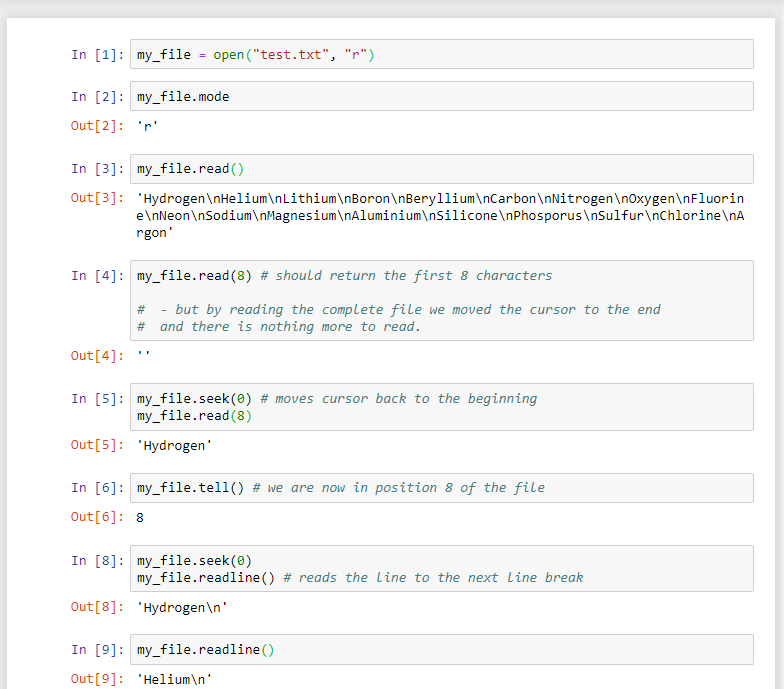
To iterate over the complete list, we can use the readlines() method. This way we can use the complete content of the file in form of a List inside our function:
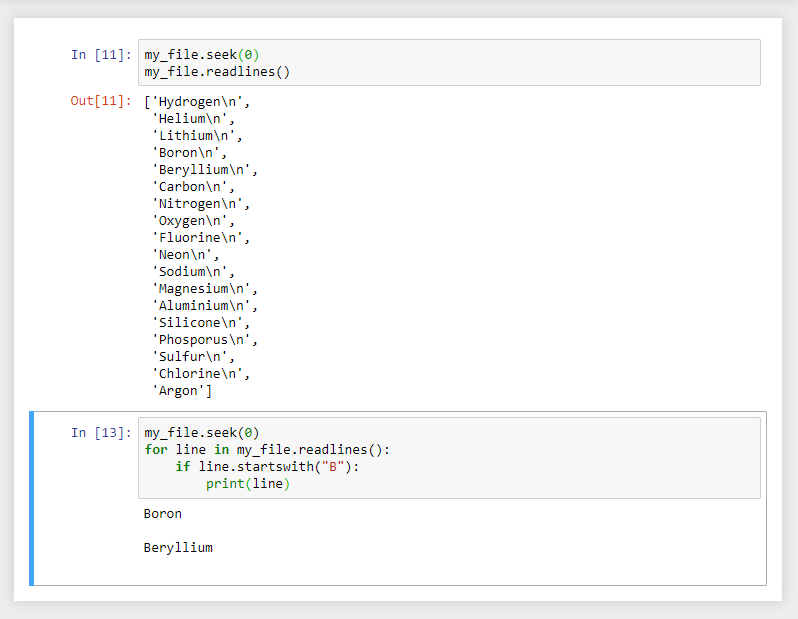
Writing
As we learnt before, we can use both the w or x method to create a new file (make sure that you have administrative access to your computer to be allowed to create the file):
my_file= open('test_data.txt', 'x')
my_file.write('Scandium\nTitanium\nVanadium\nChromium\nManganese\nIron\nCobalt\nNickel\nCopper\nZinc\nYttrium\nZirconium\nNiobium\nMolybdenum\nTechnetium\nRuthenium\nRhodium\nPalladium\nSilver\nCadmium')
my_file.close()
Check the text file - to verify that it now contains the following data:
Scandium
Titanium
Vanadium
Chromium
Manganese
Iron
Cobalt
Nickel
Copper
Zinc
Yttrium
Zirconium
Niobium
Molybdenum
Technetium
Ruthenium
Rhodium
Palladium
Silver
Cadmium
If you use the
open()function again on this file, this will overwrite the old content - that is why the thex methodexist, to prevent accidental data loss.
If you need to modify an existing file - without overwriting the existing data - you have to use the a method to append your new input:
Appending Data
my_file= open('test_data.txt', 'a')
my_file.write('\nHafnium\nTantalum\nTungsten\nRhenium\nOsmium\nIridium\nPlatinum\nGold\nMercury\nRutherfordium\nDubnium\nSeaborgium\nBohrium\nHassium\nMeitnerium\nDarmstadium\nRoentgenium\nCopernecium')
my_file.close()
Closing a File
As we have seen, we can use the close() to close a file and save our edits to it. To check the state of a file, we can use my_file.closed and will either receive a True or False.
To do a single read or write operation and closing the file automatically afterwards, we can use the following method:
Regular Expressions
To work with regular expressions you have to import re module into your program. This module offers a couple of methods that we can use:
match()
The match() method compares the beginning of the string to your query and returns the match object, if a match was found:
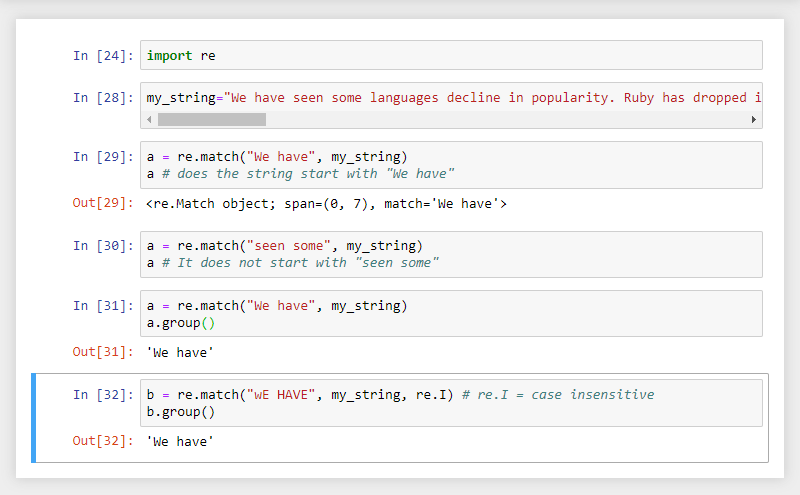
search()
The search() method check the entire string for a match. We are going to use a regular expression this time:
import re
arp = '10.112.78.1 0 ca:fe:ca:fe:b7:ce VLAN#345 L'
a = re.search(r'(.+?) +(\d) +(.+?)\s{2,}(\w)*', arp)
a
r= we are going to analyze the RAW string- First group:
(.+?).represent any character, except a new-line character+?means that the previous expression repeats one or more times - the space character after the group(.+?) SPACErepresents the stop signal for the expression. The added?stops our match before the first space10.112.78.1. If you remove the?the match will include all spaces until a new character is found10.112.78.1 SPACE.
- Second group:
SPACE +(\d)SPACE +this will flexibly match any number of space characters between the IP address from our ARP request and the following number./drepresents a single decimal digit between 0-9
- Third Group
SPACE +(.+?)\s{2,}SPACE +matches all spaces between the0and following MAC address(.+?)\s{2,}the first part.+?again matches any character. The\s{2}represents 2 repetitions of a white space character (SPACE, TAB or New-Line) - so that this block does not only include the MAC address, but also the following VLAN number that is separated by only 1 white space character. By adding a comma\s{2,}we match 2 or more white spaces and\s{1}would only take 1 whitespace - separating the MAC address from the VLAN number in the results, as the 1 whitespace between those two would already satisfy the match.
- Fourth Group
(\w)*\wmatches any character a-z, A-Z, 0-9 and the _ underscore*represents 0 or more repetitions of the character before it (+matches 1 or more repetition)
To output all matches we can use the group() method without any argument. Or use the groups() method to return the result in form of a tuple:
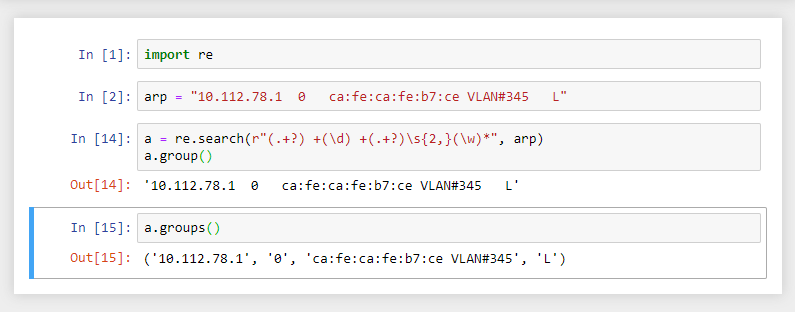
findall()
Given the same reply to an ARP request, we are now going to use the findall() method to find the IP address inside the string. This method, conveniently already returns it's match in form of a list:
import re
arp = '10.112.78.223 0 ca:fe:ca:fe:b7:ce VLAN#345 L'
a = re.search(r'\d\d\.\d{2,}\.[0-9][0-9]\.[0-9]{1,3}', arp)
a
\d\dmatches 2 single digits\.now we want to find a.character - since this character stands for any character in regular expression syntax, we need to escape it with a backslash.\d{2}is just a different way to write\d\d- note that you can extend this to\d{2,}if you need to accept IP addresses that have 2 or 3 digits inside an octet - as seen in the example.\.another escaped dot character[0-9][0-9]another way to represent 2 digits - but this also accepts a-z, A-Z and the _ underscore besides numbers.\.another escaped dot character[0-9]{1,3}and yet another way to express that we are looking for a single digit that can occur 1 - 3 times.

By surrounding every block in brackets you will get a list of tuples as a result instead - Note that we added a second IP address to the string we are matching:
a = re.search(r'(\d\d)\.(\d{2,})\.([0-9][0-9])\.([0-9]{1,3})', arp)

sub()
The sub() method substitutes every matching pattern with another string that you provide as an argument:
Object Oriented Programming
Python allows us to use classes and create multiple objects from it:
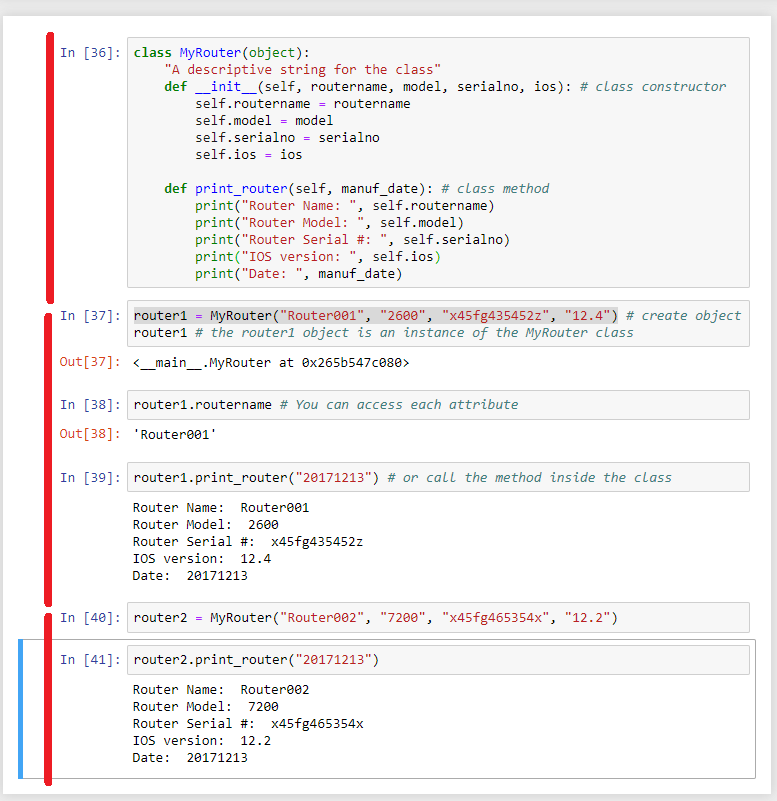
Attributes inside objects can be updated directly:
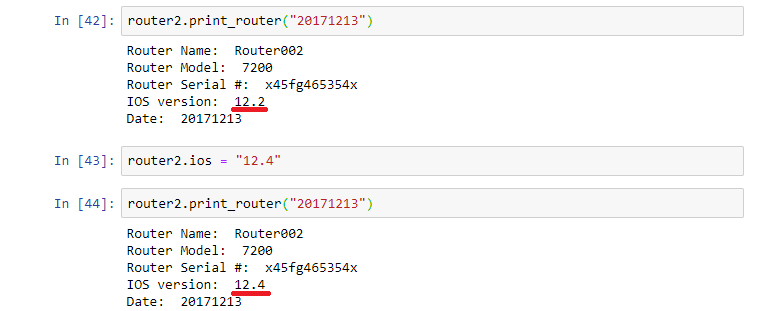
Alternatively zou can also use the getattr() or setattr() methods to to this operation. To check if an attribute is present inside an object use hasattr(). And delete an attribute with delattr()
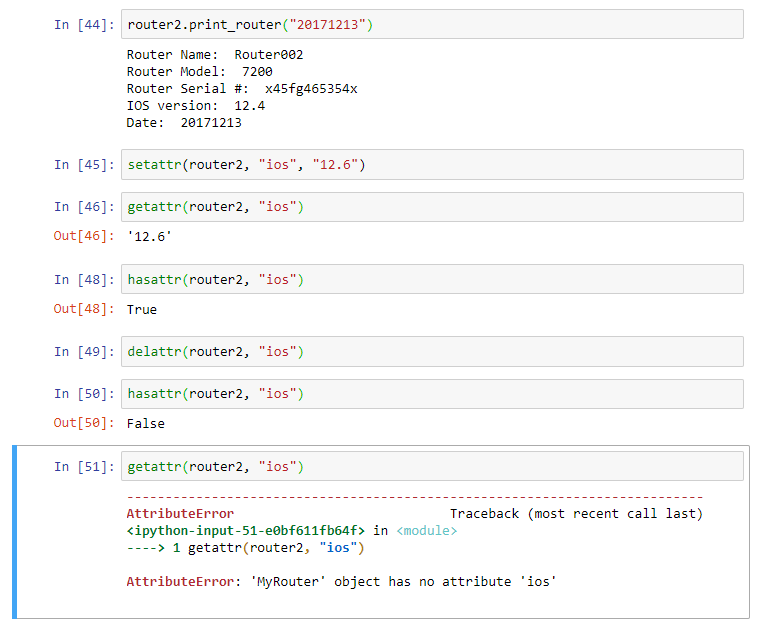
To verify what class an object belongs to, use the isinstance() - isinstance(router2, MyRouter) would get you a True in our case.
Class Inheritance
In the previous example we had a class that did not inherit any attributes from another class - it is convention in Python to add the default object object to it in such a case:
class MyRouter(object):
'A descriptive string for the class'
def __init__(self, routername, model, serialno, ios): # class constructor
self.routername = routername
self.model = model
self.serialno = serialno
self.ios = ios
def print_router(self, manuf_date): # class method
print('Router Name: ', self.routername)
print('Router Model: ', self.model)
print('Router Serial #: ', self.serialno)
print('IOS version: ', self.ios)
print('Date: ', manuf_date)
We can now use our class as parent class for our next example:
class MyNewRouter(MyRouter):
'A descriptive string for the class' # class constructor
def __init__(self, routername, model, serialno, ios, portsno):
MyRouter.__init__(self, routername, model, serialno, ios)
self.portsno = portsno
def print_new_router(self, string): # class method
print(string, self.model)
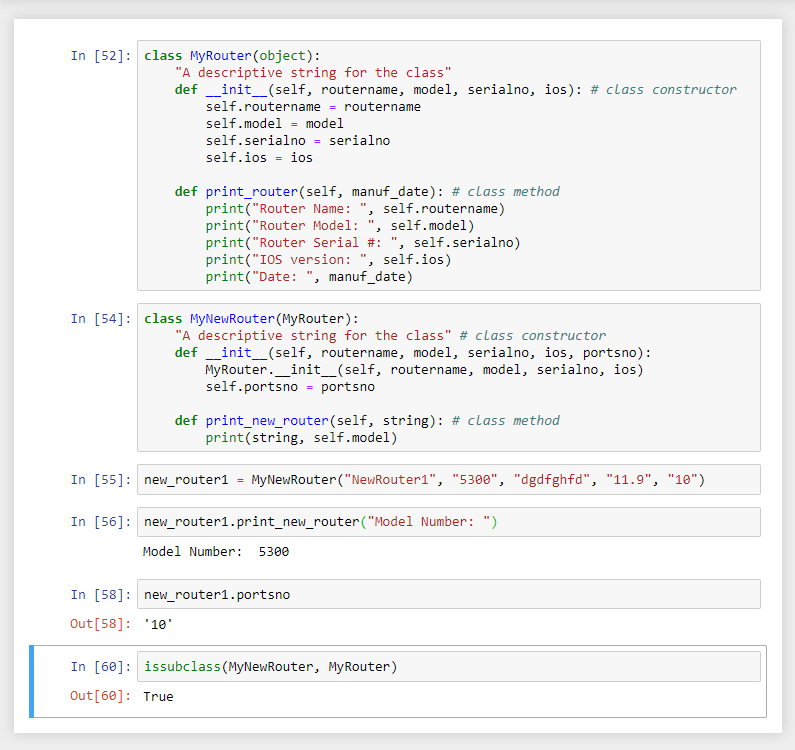
Comprehensions
List Comprehensions
Syntactically, list comprehensions consist of an iterable containing an expression followed by a for clause. This can be followed by additional for or if clauses.
Pythons List Comprehensions allows you to write the following for-loop (list1) in a single line (list2) - even adding conditional logic (list3):
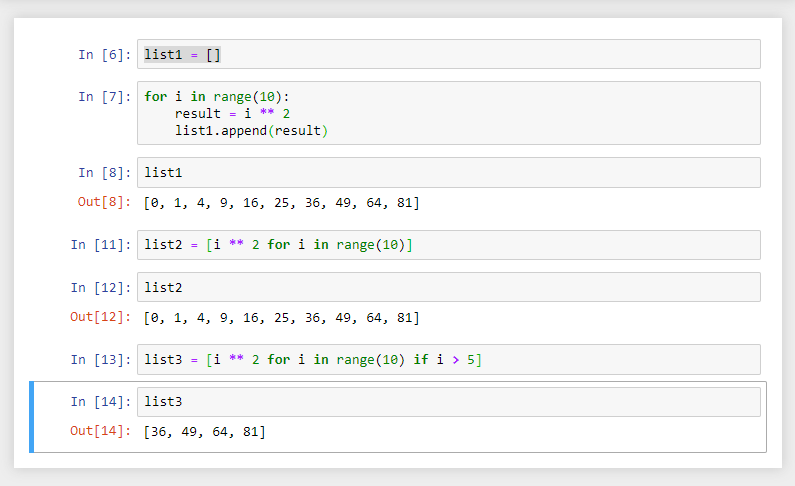
Set Comprehensions
Dictionary Comprehensions
Lambda Functions
Python use the lambda keyword to declare an anonymous function. Syntactically they look different, lambda functions behave in the same way as regular functions that are declared using the def keyword. The following are the characteristics of Python lambda functions:
- A lambda function can take any number of arguments, but they contain only a single expression. An expression is a piece of code executed by the lambda function, which may or may not return any value.
- Lambda functions can be used to return objects.
- Syntactically, lambda functions are restricted to only a single expression.
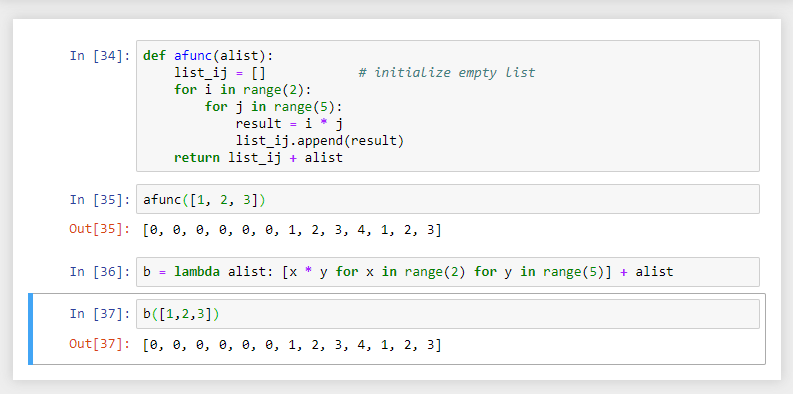
Maps
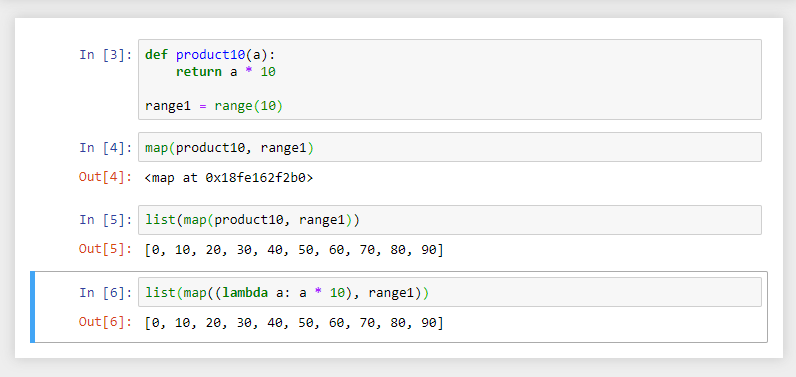
Filter
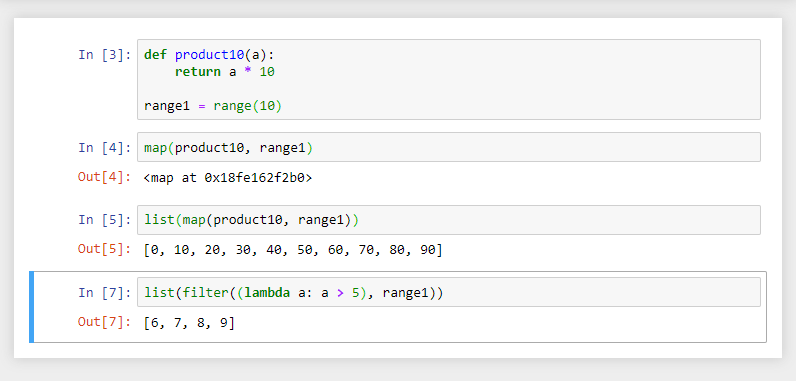
Iterator
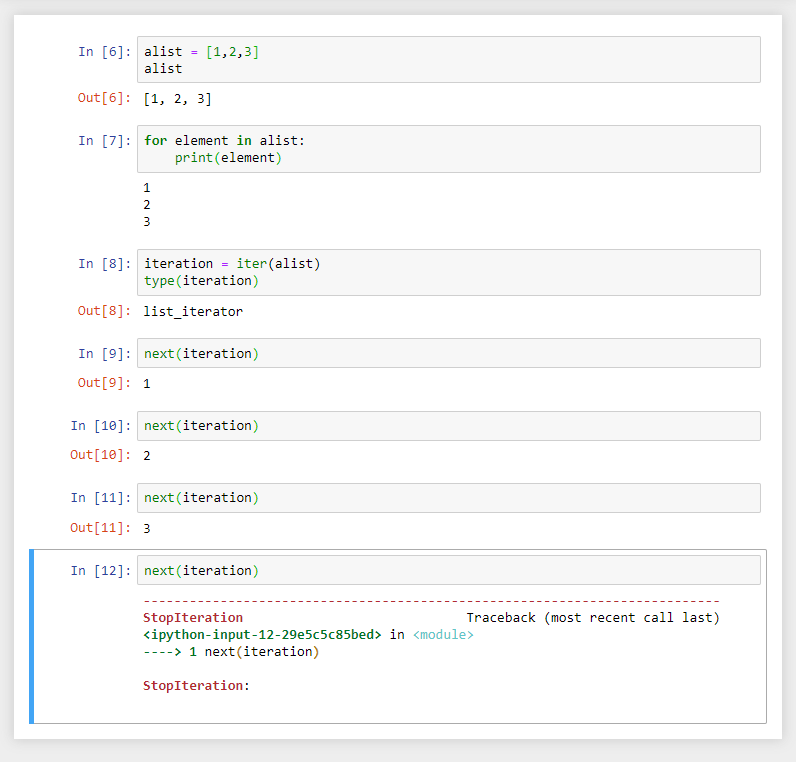
Generator
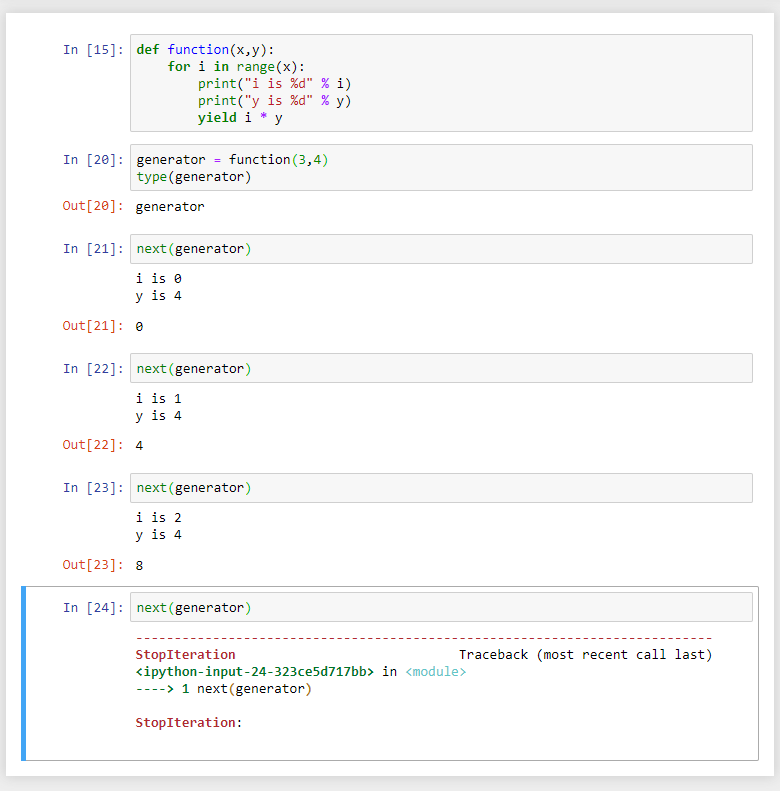
Generator Expressions
